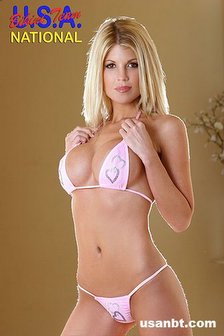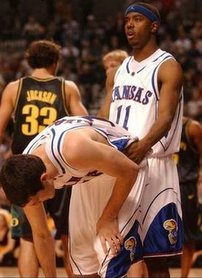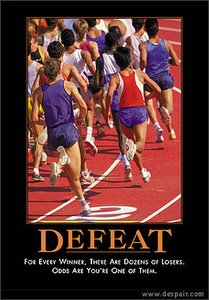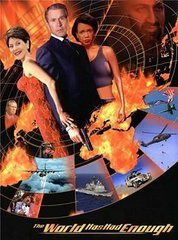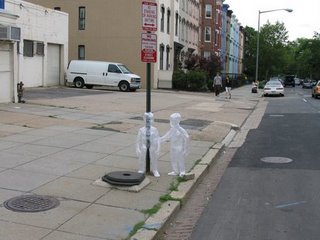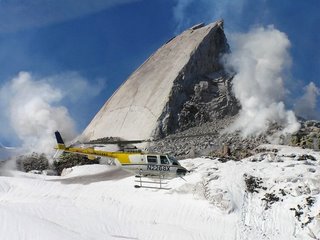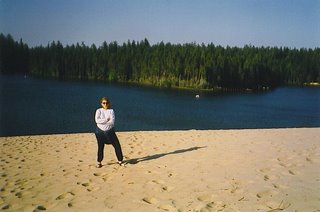"Dingers" as in home runs, of course.
Dingers! A Short History of the Long Ball by Peter Keating is the book, and it's pretty interesting for any baseball fan out there. Plus, you can read it in about a day. And you can learn things! Here are some things I learned (in rough chronological order):
Ross Barnes of the Chicago White Stockings hit the first home run in National League history in 1876.
Before
Babe Ruth came along,
Ned Williamson held the single-season record for most home runs with 27 in 1884. He never hit more than 9 in any other season. In 1894 he was voted the best player of all time by several old baseball players.
In 1894,
Bobby Lowe hit four home runs in a game. He was the first one to do this. That's not the cool thing about it. He hit all of them off of
Icebox Chamberlin, the pitcher for the Reds. Players don't get cool nicknames like "Icebox" anymore.
Ed Delahanty, who hit four home runs in a game in 1896 for the Phillies (and is in the Hall of Fame, because he was a brilliant ballplayer), died in 1903 when he fell off the International Bridge near Niagara Falls. No one knows if he committed suicide, was drunk and fell accidentally, or was pushed. There has to be a good novel in the story of Ed Delahanty.
Frank "Home Run" Baker (one of my childhood heroes) never hit more than 12 home runs in a season. However, he led the league for four straight years (1911-1914) and won two games in the 1911 World Series in dramatic fashion with home runs off
Rube Marquard and
Christy Mathewson, two Hall of Famers. Hence the nickname.
"Wahoo" Sam Crawford holds the record for most inside-the-park home runs in a season with 12 in 1901.
Jesse Burkett has the most for a career with 55.
Rogers Hornsby is the only man with more than 300 career home runs who also had more than 30 inside-the-park home runs. He had 301 home runs, 33 of which did not leave the park.
Babe Ruth and
Mark McGwire hold the record for most home runs with men on base in a season, 37. Ruth did his in 1921 with the Yankees, McGwire in 1998 with the Cardinals.
Ruth's 29 home runs for the Red Sox in 1919 not only set a record, it remains the highest percentage of a team's total for the year by one man, 87.9%. No one, not even Ruth, has ever come close to that.
Rabbit Maranville has the most at-bats in a season without hitting a home run, 672. Not surprisingly for a guy with a great nickname, he played a long time ago - he set this record for the 1922 Pirates.
Babe Ruth not only changed the way the game was played, he changed the way ballparks were built. In the 1920s, owners started bringing the fences in to encourage more home runs. Ebbets Field in Brooklyn originally had a left field fence 419 feet from home plate. By the time
Gil Hodges and
Roy Campanella played there, it was 343 feet away.
Al Simmons and
Alex Rodriguez have both hit 5 home runs on their birthday, which is the most in history.
In the post-war years, teams continued to move fences in, leading to records for home runs in a season for the major leagues in 1949, 1950, 1953, 1955, and 1956. Integration helped boost the totals as well, something often overlooked.
Robin Roberts, the Phillies' Hall of Fame pitcher, led the league in home runs allowed five times during his career (and holds the record for most allowed in a career), including 46 in 1956, but he didn't walk anyone, so they were lots of solo homers. Roberts showed the way pitchers had to pitch in the new era - deal with home runs, but don't walk anyone!
The 1952 New York Giants were the first team with 9 players hitting 10 or more home runs.
Seven times has a player hit more than 40 homers and struck out less than 40 times in a season. The last to do it was
Ted Kluszewski in 1955, the third year in a row he had accomplished it.
In the 1960s teams moved to the suburbs, owners built new ballparks that were "multi-functional" and larger (because of the extra suburban room) and home run totals dropped. Which is why
Aaron's home run totals are so astonishing, because Milwaukee had a horrible home run park. Home runs dropped, attendance dropped, and owners began moving the fences in again.
Tony Conigliaro holds the record for most home runs hit as a teenager with 24.
Aaron was hurt early in his career by playing in County Stadium, and helped late in his career - when most players decline - because he played in Atlanta-Fulton County Stadium, a great hitters' park. Thus, he looks like a model of consistency, because his years in Milwaukee kept his totals down a bit, and his years in Atlanta pumped them up a bit.
Willie Mays has hit the most extra-inning home runs in a career, 22.
Free agency, which began in 1976, meant players took much better care of themselves than previously because they had much greater earning potential. Therefore,
Eddie Murray could hit over 500 home runs without ever hitting even 35 in a season.
Dave Kingman led the National League in home runs in 1982 with 37 - and batted .204.
Ruth led the league in home runs the most times - 12. The second most times leading the league, with 8?
Michael Jack Schmidt. Keep
Brooks Robinson, Baltimore fans. Schmidt is the best third baseman in history. In 2002, sportswriter Allen Barra made the argument that Schmidt is the player of the 20th century.
In 1986 the Rangers beat the Orioles 13-11, the first game in which three grand slams were hit. In 1987 the Cubs beat the Astros 22-7, the second game in which three grand slams were hit.
Don Mattingly hit six grand slams in 1987, setting a record for most slams in a season. He never hit another one.
On April 13, 1987,
Marvell Wynne,
Tony Gwynn, and
John Kruk of the Padres hit back-to-back-to-back home runs to start a game - the only time that's ever happened.
Lou Gehrig has hit the most grand slams ever, 23. But
Manny Ramirez has 20.
Fernando Tatis (?!) is the only player to hit two grand slams in one inning, in 1999. Nine other players have hit two in a game.
Brady Anderson's jump from 16 home runs in 1995 to 50 in 1996 is the biggest jump in home runs in one year ever. Lou Gehrig is second, going from 16 in 1926 to 47 in 1927, but nobody accused him of being on steroids!
In the 1990s, teams started returning to downtown areas and building smaller ballparks. Camden Yards (Baltimore), Coors Field (Denver), the Ballpark at Arlington (Arlington), the Great American Ballpark (Cincinnati), and Citizens Bank Park (Philadelphia) are examples of this. The result: more home runs!
Based on previous players and their performance late in their careers, at the beginning of the season
Barry Bonds should have had 634 home runs. Yet he had 708. Good conditioning, or performance-enhancing drugs? You be the judge. Through 1999, his career high in home runs was 46, and he had been in the league for 14 years. Since then he has hit 49, 73, 46, 45, and 45 home runs before he was injured last year. I have always hated Barry Bonds, but this is not about hating him. It's about cheating. I think he's a cheater, which is a shame, because for the first 15 years of his career, he was a great player without drugs.
Based on percentage of home runs that tied games or gave their teams the lead,
Craig Biggio and
Gary Sheffield are the two most clutch home run hitters currently playing.
Before
Julio Franco hit a home run this year, the oldest person to hit a home run was a pitcher,
Jack Quinn, who hit one in 1930 when he was 46. In 1929
Connie Mack started him in the first World Series game against the Cubs, and he beat them. It was his last moment of glory. Except for that home run, maybe.
Alex Rodriguez has only a 30% chance of passing Henry Aaron.
Albert Pujols, everyone's favorite player right now, has a 15% chance.
Harry Davis hit the most home runs for the years 1900-1909: 67 of them.
Gavvy Cravath hit the most home runs for the years 1910-1919: 116 of them.
Babe Ruth hit the most home runs for the years 1920-1929: 467 of them (duh!).
Jimmie Foxx, one of the great forgotten home run hitters of the game, hit the most home runs for the years 1930-1939: 415 of them.
Ted Williams hit the most home runs for the years 1940-1949: 234 of them. The war, obviously, skewed these numbers. Many players, Williams included, lost three or four years of their prime when they went and fought. Williams later went to Korea, too. And he still hit 521 home runs.
Duke Snider hit the most home runs for the years 1950-1959: 326 of them.
Harmon Killebrew hit the most home runs for the years 1960-1969: 393 of them.
Willie Stargell hit the most home runs for the years 1970-1979: 296 of them.
Mike Schmidt hit the most home runs for the years 1980-1989: 313 of them.
Mark McGwire hit the most home runs for the years 1990-1999: 405 of them.
Alex Rodriguez hit the most home runs for the years 2000-2005: 281 of them.
Ruth ('20s and '30s), Gehrig ('20s and '30s), Mays ('50s and '60s),
Mantle ('50s and '60s), Schmidt ('70s and '80s), Bonds ('90s and '00s), and
Sosa ('90s and '00s) are the only players to appear in the top ten in home runs for two different decades.
It's a fascinating book. It also points out how unbelievable Babe Ruth is and how Aaron and Bonds can't hope to replace him. Ruth was the first person to hit 30, 40, 50, and 60 home runs in a season. In the 1920s he hit 217 more home runs than the second-best hitter, Rogers Hornsby. He broke the single-season home run record in 1919, 1920, 1921, and 1927. There was never a player like him, and it's impossible that there will ever be another like him. So Barry Bonds can pass him all he wants - and so can Alex Rodriguez and Albert Pujols. There's only one Babe Ruth. By the way, he also won 20 games twice, had a lifetime ERA of 2.28, and held the record for most consecutive scoreless innings in a World Series for forty years or so.
My mother comes to town tomorrow, so I have decided to keep things short for a while. My posts over the next week will be either brilliantly pithy observations about life or devastatingly probing philosophical questions that will make your brain explode! Oh, what fun! Be sure to check back and shake your head in wonderment!
Labels: Babe Ruth, Books, History, Home runs, Sports, What I've been reading

















